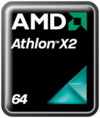Athlon 64 X2
 | |
| Produced | From 2005 |
|---|---|
| Marketed by | AMD |
| Designed by | AMD |
| Common manufacturer(s) |
|
| Max. CPU clock rate | 1.9 GHz to 3.2 GHz |
| HyperTransport speeds | 1 GHz to 1.8 GHz |
| Min. feature size | 90 nm to 65 nm |
| Instruction set | MMX, SSE, SSE2, SSE3, x86-64, 3DNow! |
| Microarchitecture | ("Kuma" based models are K10 derived) |
| Cores | 2 |
| Socket(s) |
|
The Athlon 64 X2 is the first dual-core desktop CPU designed by AMD. It was designed from scratch as native dual-core by using an already multi-CPU enabled Athlon 64, joining it with another functional core on one die, and connecting both via a shared dual-channel memory controller/north bridge and additional control logic. The initial versions are based on the E-stepping model of the Athlon 64 and, depending on the model, have either 512 or 1024 KB of L2 Cache per core. The Athlon 64 X2 is capable of decoding SSE3 instructions (except those few specific to Intel's architecture).
In June 2007, AMD released low-voltage variants of their low-end 65 nm Athlon 64 X2, named "Athlon X2".[1] The Athlon X2 processors feature reduced TDP of 45 W.[2] The name was also used for K10 based budget CPUs with two cores deactivated.
Multithreading
The primary benefit of dual-core processors (like the Athlon 64 X2) over single-core processors is their ability to process more software threads at the same time. The ability of processors to execute multiple threads simultaneously is called thread-level parallelism (TLP). By placing two cores on the same die, the X2 effectively doubles the TLP over a single-core Athlon 64 of the same speed. The need for TLP processing capability is dependent on the situation to a great degree, and certain situations benefit from it far more than others. Certain programs are currently written for only one thread, and are therefore unable to utilize the processing power of the second core.
Programs often written with multiple threads and capable of utilizing dual-cores include many music and video encoding applications, and especially professional rendering programs. High TLP applications currently correspond to server/workstation situations more than the typical desktop. These applications can realize almost twice the performance of a single-core Athlon 64 of the same specifications. Multi-tasking also runs a sizable number of threads; intense multi-tasking scenarios have actually shown improvements of considerably more than two times.[3] This is primarily due to the excessive overhead caused by constantly switching threads, and could potentially be improved by adjustments to operating system scheduling code.
In the consumer segment of the market as well, the X2 improves upon the performance of the original Athlon 64, especially for multi-threaded software applications.
Manufacturing costs
Having two cores, the Athlon 64 X2 has an increased number of transistors. The 1 MB L2 cache 90 nm Athlon 64 X2 processor is 219 mm² in size with 243 million transistors [4] whereas its 1 MB L2 cache 90 nm Athlon 64 counterpart is 103.1 mm² and has 164 million transistors.[5] The 65 nm Athlon 64 X2 with only 512 KB L2 per Core reduced this to 118 mm² with 221 million transistors compared to the 65 nm Athlon 64 with 77.2 mm² and 122 million transistors. As a result, a larger area of silicon must be defect free. These size requirements necessitate a more complex fabrication process, which further adds to the production of fewer functional processors per single silicon wafer. This lower yield makes the X2 more expensive to produce than the single-core processor.
In the middle of June 2006 AMD stated that they would no longer make any non-FX Athlon 64 or Athlon 64 X2 models with 1 MB L2 caches.[6] This led to only a small production number of the Socket-AM2 Athlon 64 X2 with 1 MB L2 cache per core, known as 4000+, 4400+, 4800+, and 5200+. The Athlon 64 X2 with 512 KB per core, known as 3800+, 4200+, 4600+, and 5000+, were produced in far greater numbers. The introduction of the F3 stepping then saw several models with 1 MB L2 cache per core as production refinements resulted in an increased yield.
CPU cores
Athlon 64 X2
| AMD Athlon X2 processor family | |||
|---|---|---|---|
| AMD K9 | Desktop | ||
| Code-named | Core | Date released | |
 |
Manchester Toledo Windsor |
dual (90 nm) dual (90 nm) dual (90 nm) |
May 2005 May 2005 May 2006 |
 |
Toledo Windsor |
dual (90 nm) dual (90 nm) |
Jan 2006 May 2006 |
 |
Brisbane |
dual (65 nm) | Dec 2006 |
| List of AMD Athlon 64 X2 microprocessors | |||
Manchester (90 nm SOI)
- CPU-Stepping: E4
- L1-Cache: 64 + 64 KB (Data + Instructions), per core
- L2-Cache: 256, 512 KB fullspeed, per core
- MMX, Extended 3DNow!, SSE, SSE2, SSE3, AMD64, Cool'n'Quiet, NX Bit
- Socket 939, HyperTransport (1000 MHz, HT1000)
- VCore: 1.35 V - 1.4 V
- Power Consumption (TDP): 89 Watt
- First Release: 1 August 2005
- Clockrate: 2000 - 2400 MHz
- 256 KB L2-Cache:
- 3600+: 2000 MHz
- 512 KB L2-Cache:
- 3800+: 2000 MHz
- 4200+: 2200 MHz
- 4600+: 2400 MHz (110 Watt TDP)
- 256 KB L2-Cache:
Toledo (90 nm SOI)
- CPU-Stepping: E6
- L1-Cache: 64 + 64 KB (Data + Instructions), per core
- L2-Cache: 512 or 1024 KB fullspeed, per core
- MMX, Extended 3DNow!, SSE, SSE2, SSE3, AMD64, Cool'n'Quiet, NX Bit
- Socket 939, HyperTransport (1000 MHz, HT1000)
- VCore: 1.35 V - 1.4 V
- Power Consumption (TDP):
- 89 Watt: 3800+, 4200+ and 4400+
- 110 Watt: 4400+, 4600+ and 4800+
- First Release: 21 April 2005
- Clockrate:: 2000 - 2400 MHz
- 512 KB L2-Cache:
- 3800+: 2000 MHz
- 4200+: 2200 MHz
- 4600+: 2400 MHz
- 1024 KB L2-Cache:
- 4400+: 2200 MHz
- 4800+: 2400 MHz
- 512 KB L2-Cache:
Windsor (90 nm SOI)
%2C_heat_spreader_removed.jpg)
- CPU-Stepping: F2, F3
- L1-Cache: 64 + 64 KB (Data + Instructions), per core
- L2-Cache: 256, 512 or 1024 KB fullspeed, per core
- MMX, Extended 3DNow!, SSE, SSE2, SSE3, AMD64, Cool'n'Quiet, NX Bit, AMD-V
- Socket AM2, HyperTransport (1000 MHz, HT1000)
- VCore: 1.25 V - 1.35 V
- Power Consumption (TDP):
- 35 Watt (3800+ EE SFF)
- 65 Watt (3600+ to 5200+ EE)
- 89 Watt (3800+ to 6000+)
- 125 Watt (6000+ to 6400+)
- First Release: May 23, 2006
- Clockrate: 2000 MHz - 3200 MHz
- 256 KB L2-Cache:
- 3600+: 2000 MHz
- 512 KB L2-Cache: (often mislabeled as Brisbane core)
- 3800+: 2000 MHz
- 4200+: 2200 MHz
- 4600+: 2400 MHz (F2&F3)
- 5000+: 2600 MHz (F2&F3)
- 5400+: 2800 MHz (F3)
- 1024 KB L2-Cache:
- 4000+: 2000 MHz
- 4400+: 2200 MHz
- 4800+: 2400 MHz
- 5200+: 2600 MHz (F2&F3)
- 5600+: 2800 MHz (F3)
- 6000+: 3000 MHz (F3)
- 6400+: 3200 MHz (F3)
- 256 KB L2-Cache:
Brisbane (65 nm SOI)

- CPU-Stepping: G1, G2
- L1-Cache: 64 + 64 KB (Data + Instructions), per core
- L2-Cache: 512 KB fullspeed, per core
- MMX, Extended 3DNow!, SSE, SSE2, SSE3, AMD64, Cool'n'Quiet, NX Bit, AMD-V
- Socket AM2, HyperTransport (1000 MHz, HT1000)
- VCore: 1.25 V - 1.35 V
- Die Size: 126 mm²
- Power Consumption (TDP): 65 Watt / 89 Watt
- First Release: Dec 5, 2006
- Clockrate: 1900 MHz - 3100 MHz
- 3600+: 1900 MHz (G1)
- 3800+: 2000 MHz
- 4000+: 2100 MHz
- 4200+: 2200 MHz (G1&G2)
- 4400+: 2300 MHz (G1&G2)
- 4600+: 2400 MHz (G2)
- 4800+: 2500 MHz (G1&G2)
- 5000+: 2600 MHz (G1&G2)
- 5200+: 2700 MHz (G1&G2)
- 5400+: 2800 MHz (G2)
- 5600+: 2900 MHz (G2)
- 5800+: 3000 MHz (G2)
- 6000+: 3100 MHz (G2)
Athlon X2
'64' was omitted from the name of the Brisbane 'BE' series; the 64-bit marketing campaign initiated by AMD became insignificant once essentially all consumer CPUs became 64-bit processors.
Brisbane (65 nm SOI)
- CPU-Stepping: G1, G2
- L1-Cache: 64 + 64 KB (Data + Instructions), per core
- L2-Cache: 512 KB fullspeed, per core
- MMX, Extended 3DNow!, SSE, SSE2, SSE3, AMD64, Cool'n'Quiet, NX Bit, AMD-V
- Socket AM2, HyperTransport (1000 MHz, HT1000)
- VCore: 1.15 V - 1.20 V
- Die Size: 118 mm²
- Power Consumption (TDP): 45 Watt
- First Release: June 1, 2007
- Clockrate: 1900 MHz - 2600 MHz
- BE-2300: 1900 MHz (G1&G2)
- BE-2350: 2100 MHz (G1&G2)
- BE-2400: 2300 MHz (G2)
- 4050e: 2100 MHz (G2)
- 4450e: 2300 MHz (G2)
- 4850e: 2500 MHz (G2)
- 5050e: 2600 MHz (G2)
Kuma (65 nm SOI)
- Chip harvests from Agena with two cores disabled[7]
- AMD K10 Microarchitecture
- CPU-Stepping: B3
- L1-Cache: 64 + 64 KB (Data + Instructions), per core
- L2-Cache: 512 KB fullspeed, per core
- L3-Cache: 2 MB (shared)
- MMX, SSE, SSE2, SSE3, SSE4a, Enhanced 3DNow!, NX bit, AMD64, Cool'n'Quiet, AMD-V
- Socket AM2+, HyperTransport (1800 MHz, HT3.0)
- VCore: 1.05 V - 1.25 V
- Die Size: 288 mm²
- Power Consumption: (TDP): 95 Watt
- First Release: December 15, 2008
- Clockrate: 2300 - 2800 MHz
- 6500BE: 2300 MHz
- 7450: 2400 MHz
- 7550: 2500 MHz
- 7750BE: 2700 MHz
- 7850BE: 2800 MHz
See also
- List of AMD Athlon X2 microprocessors
- List of AMD Athlon 64 microprocessors
- List of AMD microprocessors
- Parallel computing
References
- ↑ AMD FAQ on removing the "64" Archived June 10, 2010, at the Wayback Machine.
- ↑ DailyTech report
- ↑ http://www.anandtech.com/cpuchipsets/showdoc.aspx?i=2397&p=21
- ↑ "Transistors Reference". innoreviews.com. Retrieved 2016-04-29.
- ↑ http://www.amd.com/us-en/Processors/ProductInformation/0,,30_118_9485_9487^10248,00.html[]
- ↑ HardOCP report
- ↑ https://docs.google.com/spreadsheets/d/19Ms49ip5PBB7nYnf5urxsySvH-Sdy6liE2EBDaB8b54
External links
- Athlon64 X2 product site
- Comparison with the Intel Core Duo
- AMD Athlon 64 Power and Thermal Data Sheet site (PDF)